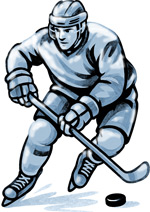The T-Test is a simple running test of agility, involving forward, lateral, and backward movements, appropriate to a wide range of sports.
test purpose: the T-Test is a test of agility for athletes, and includes forward, lateral, and backwards running.
equipment required: tape measure, marking cones, stopwatch, timing gates (optional)
pre-test: Explain the test procedures to the subject. Perform screening of health risks and obtain informed consent. Prepare forms and record basic information such as age, height, body weight, gender, test conditions. Measure and mark out test area. Perform an appropriate warm-up. See more details of pre-test procedures.

test setup: Set out four cones as illustrated in the diagram above (5 yards = 4.57 m, 10 yards = 9.14 m).
procedure: The subject starts at cone A. On the command of the timer, the subject sprints to cone B and touches the base of the cone with their right hand. They then turn left and shuffle sideways to cone C, and also touches its base, this time with their left hand. Then shuffling sideways to the right to cone D and touching the base with the right hand. They then shuffle back to cone B touching with the left hand, and run backwards to cone A. The stopwatch is stopped as they pass cone A.
scoring: The trial will not be counted if the subject crosses one foot in front of the other while shuffling, fails to touch the base of the cones, or fails to face forward throughout the test. Take the best time of three successful trials to the nearest 0.1 seconds. The table below shows some scores for adult team sport athletes.
| Males (seconds) | Females (seconds) | |
|---|---|---|
| Excellent | < 9.5 | < 10.5 |
| Good | 9.5 to 10.5 | 10.5 to 11.5 |
| Average | 10.5 to 11.5 | 11.5 to 12.5 |
| Poor | > 11.5 | > 12.5 |
comments: Ensure that the participants face forwards when shuffling and do not cross the feet over one another. For safety, a spotter should be positioned a few meters behind cone A to catch players in case they fall while running backward through the finish.
reliability: the type of surface that is used should be consistent to ensure good test-retest reliability
advantages: This is a simple agility test to perform, requiring limited equipment and space.
disadvantages: Only one person can perform the test at a time.
references:
- Semenick, D. (1990). The T-test. NSCA Journal, 12(1), 36-37.
- PAUOLE KAINOA; MADOLE, KENT; GARHAMMER, JOHN; LACOURSE, MICHAEL; ROZENEK, RALPH. (2000). Reliability and Validity of the T-Test as a Measure of Agility, Leg Power, and Leg Speed in College-Aged Men and Women. The Journal of Strength & Conditioning Research. 14. 10.1519/00124278-200011000-00012.
Similar Tests
- Simple 1-minute side step test
- 20m 5-10-5 agility shuttle — run 5 meters to one side, 10 meters back the other way, finishing with 5 meters back to the start line.
- FIFA Change of Direction Ability (CODA) Test — forwards and sideways running over 8-10 meters.
- SEMO Agility run — run around a rectangular area incorporating forward sprints, diagonal backpedaling, and side shuffling.



